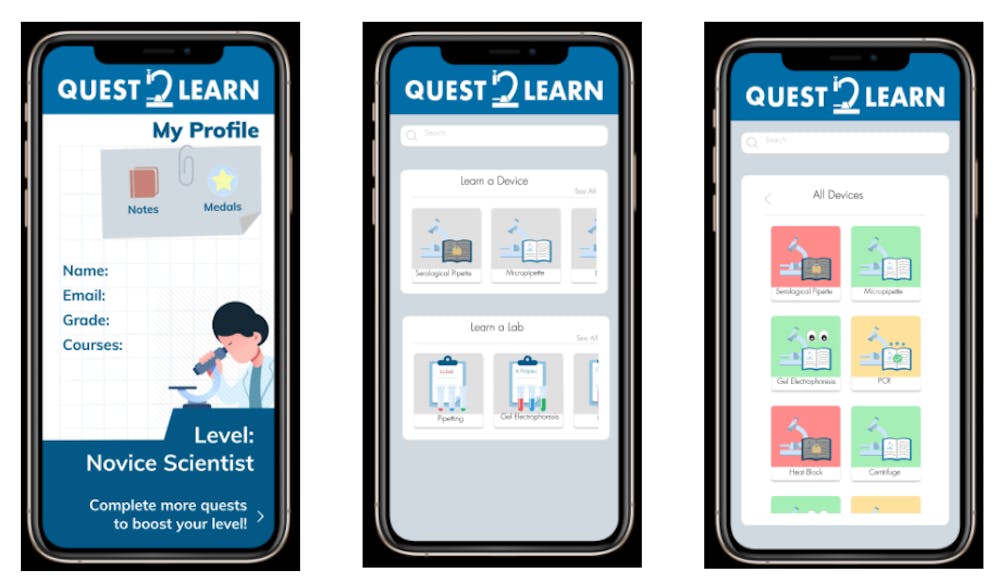A group of Hopkins undergraduate and graduate students are working together to change the way students engage with their virtual lab classes.
Their new app Quest2Learn uses augmented reality to project a virtual lab onto any flat surface through a phone screen. It also uses a gamified approach to help students learn basic wet lab skills.
At a time when many science, technology, engineering and mathematics (STEM) students at Hopkins feel dissatisfied by the caliber of online lab classes, Quest2Learn offers one example of a formidable improvement in course delivery that could come in future semesters.
The Quest2Learn team is led by MD-PhD student Shannon Wongvibulsin and consists of about 15 undergraduates from the Homewood Campus. In addition, Biology Professor Eric Johnson contributes his course materials and expertise to ensure that the platform is teaching correct lab techniques.
The team came together in late spring during the national lockdowns and has stayed together throughout the summer and fall. Five undergraduate team members — junior Computer Science and Applied Mathematics & Statistics major Ariel Bao, sophomore Computer Science major Siddharth Ananth, sophomore Biomedical Engineering major Rahul Swaminathan, sophomore Computer Science major Chinat Yu and sophomore Biophysics major Jeffery Zhou — sat down last week for interviews with The News-Letter.
The group tentatively works free of charge with professors to adapt specific courses to a digital format, a process that involves extensive coordination between biology, engineering and augmented reality (AR) teams.
AR, which superimposes a computer-generated image onto a user image, has grown in popularity in the past five years due to apps like Google Maps and Pokémon Go.
The AR team had to work carefully in order to ensure that the objects they projected, such as a beaker or pipette, had the right proportions in the human world. The team also had to ensure their application was able to distinguish between a user’s swipe or click with precision.
Ananth involved himself heavily in the AR aspect of the project and reflected on what the experience meant for him.
“I got a chance to meet new people, whereas I would have been bored sitting at home. I’ve really enjoyed working with this team so far,” he said.
Swaminathan described his own experience trying to learn about laboratory practices while distance learning.
“I’m taking a biochemistry class right now, and when I read about all these experiments I’m like, ‘Wow, I wish I could have done that in person,’” he said. “That goal of having a low-cost, also safer, alternative is really something special.”
For the time being, the app is open to testing from any interested individuals.
STEM students across the country have seen disruptions to their lab classes since the pandemic began, and offering virtual labs in lieu of simply giving students an experiment’s results has been mostly favored.
For example, Cornell University and schools in the California State system that turned to virtual labs have seen positive results that may allow these platforms to have continued use post-pandemic.
In general, virtual labs are less expensive, less time-consuming and more forgiving toward potential mistakes. Especially in the case of labs that are designed to reinforce concepts or teach the scientific method, virtual labs can be valuable even after the days of social distancing are over.
Bao remains hopeful about the prospect of Quest2Learn being used for pre-lab preparation for in-person classes when schools reopen.
“We discovered that a lot of people don’t read [the pre-lab] before the lab session itself because it’s too long and very dense with words,” Bao said. “We thought if it’s displayed in a visual format, it would probably help them.”
Zhou and Bao were also enthusiastic about generalizing the material on the app in the future. Instead of being associated with a specific course, the app’s tutorials could be used to introduce underprivileged students to STEM fields.
“There’s a big shortage of [high school] labs, especially in Baltimore, and I think this app could help a lot with that issue,” Zhou said.
For many high schools, a STEM education comes with a significant price tag. The investment associated with offering a history class, for example, is much lower than that of a chemistry class that requires facilities and materials for labs. When expanded, Quest2Learn could offer a solution to some of the major expenses associated with science education.
As of recently, the Quest2Learn team has applied for the Hopkins Student Initiatives Fund to receive more financial support, and they are working on expanding their lab offerings to include topics in chemistry and epidemiology.
“I’m curious and excited to see how far this project will go,” Bao said.
As the app gains traction, she remains hopeful that their work can create a meaningful impact at Hopkins and beyond.
To learn more about Quest2Learn and download the app for Android, visit their website or send them an email at quest2learn00@gmail.com.





